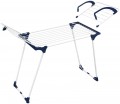Design
The method of bringing the dryer into working position. The use of one or another design option is usually directly related to the type of device (see above).
—
Folding. The conventional design for floor and outdoor dryers involves movable connections between individual parts, enabling the device to unfold and fold. The specific unfolding format varies; for instance, floor models may resemble ironing boards in this configuration, while outdoor models often resemble inverted umbrellas.
—
Sliding. This design incorporates retractable elements, with wall dryers being the most common example. Various options exist: in some models, rigid rods come close during folding and extend to the desired distance when unfolded, while others use ropes stretched between the main unit with a coil and fasteners on the opposite wall as rod substitutes. It's worth mentioning that certain folding floor dryers may also feature retractable elements, and the description typically specifies both construction types for such cases.
—
Liana. In these dryers, each rod is suspended by ropes, threaded through a special block enabling height adjustment. When in use, these rods can be set at a considerable height and lowered for convenient hanging or removal of laundry. Liana is predominantly present in models offering
ceiling installation o
...ptions (refer to "Type").
Note that some models (primarily suspended ones) may not provide folding at all — the “Design” parameter is not indicated for them.Total working surface
Under the total working surface is meant the total length of all drying rods in the expanded state. The
longer this length, the more laundry can be placed on the dryer and, usually, its maximum load is higher (see below). At the same time, this parameter also affects the dimensions and price of the device.
Max. load
The highest weight of laundry that can be dried (of course, we are talking about wet laundry). In addition to the general weight limit, the detailed specifications can also specify the allowable load on each individual rod.
At home, it is impossible to accurately control compliance with this limitation, but it is still worth taking measures to prevent overload. After all, although many drying racks have a certain margin of safety and can carry a lot of weight without visible consequences, off-design loads on the structure reduce its durability and increase the risk of unexpected breakdown.
Number of rods
The number of individual rods provided for in the design of the drying rack. The more such rods are provided for with the same total working surface, the shorter the length of each of them and the more compact the dimensions of the device in the unfolded state can be. On the other hand, short rods are poorly suited for sheets, blankets and other large items.
Dimensions (unfolded)
General dimensions of the drying rack in working position, taking into account all additional elements — side wings (see above), retractable parts (see "Design"), etc. This parameter will allow you to estimate how much space is required to use a particular model.
Dimensions (folded)
General dimensions of drying rack in the folded position. The smaller they are, the more convenient this model is in storage and transportation.



